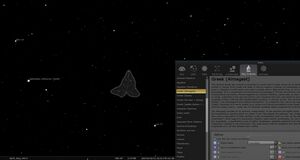Phyllon Kissinou: Difference between revisions
No edit summary |
No edit summary |
||
| Line 1: | Line 1: | ||
{{DISPLAYTITLE:Phyllon Kissinou (φύλλοv κισσίνου)}} |
{{DISPLAYTITLE:Phyllon Kissinou (φύλλοv κισσίνου)}} |
||
[[File:IvyLeaf stellarium 2024.jpg|alt=Ptolemy's "Ivy Leaf" as shape of the "nebulous mass" (star cluster) of Coma Berenices, in Stellarium |thumb|Ptolemy's "Ivy Leaf" as shape of the "nebulous mass" (star cluster) of Coma Berenices, in Stellarium ]] |
[[File:IvyLeaf stellarium 2024.jpg|alt=Ptolemy's "Ivy Leaf" as shape of the "nebulous mass" (star cluster) of Coma Berenices, in Stellarium |thumb|Ptolemy's "Ivy Leaf" as shape of the "nebulous mass" (star cluster) of Coma Berenices, in Stellarium ]]Phyllon Kissinou is a name for an asterism in the Almagest star catalogue (137 BCE). The term originates from the phrase "φύλλοv κισσίνου (phyllon kissinou, an ivy leaf)" in Ptolemy's Almagest which was the reason to use the full Greek term as a star name. Contemporary modern astronomers have used the star name "Kissin"; therefore, it has been suggested that it be made official. |
||
== Etymology & History == |
== Etymology & History == |
||
Revision as of 05:29, 3 August 2024
Phyllon Kissinou is a name for an asterism in the Almagest star catalogue (137 BCE). The term originates from the phrase "φύλλοv κισσίνου (phyllon kissinou, an ivy leaf)" in Ptolemy's Almagest which was the reason to use the full Greek term as a star name. Contemporary modern astronomers have used the star name "Kissin"; therefore, it has been suggested that it be made official.
Etymology & History
The Almagest star catalogue is a dataset provided for globe makers.[1][2] For small or faint star clusters, Ptolemy typically does not provide lists of coordinates per star but only mentions one or a few points of the cluster and then gives the instruction to connect them as a fuzzy (nebulous) area.[3] In the case of Coma Berenices (πλόκαμος), he describes the shape of the star cluster as an ivy leaf (φύλλοv κισσίνου, phyllon kissinou). After introducing the "nebulous mass" mathematically described by three pairs of coordinates, he states, "the rearmost of them [in the nebulous mass between the edges of Leo and Ursa Major, called Coma Berenices], shaped like an ivy leaf". This means his ivy leaf is described with three stars, among which 23 Com is the last in his register. Allen (1899) identifies "21 or 23 Com", and Rhoads (1971) has "Kissin" for 21 Com, but Ptolemy's coordinates fit 23 Com much better (cf. Toomer[1] 1984, Grasshoff[4] 1990 and all research based upon them).
Modern Usage of the Name
The name "Kissin" derived from "phyllon kissinou" has been used for different stars:
- Rhoads (1971) has "Kissin" for 21 Com, cites the Bright Star Catalog.
- Allen (1899):
- Hyde cited some ancient codices as applying to Fl. 21, toward the south, the title Kissīn, a species of Ivy, Convolvulus (bindweed), or perhaps the climbing Dog-rose. This appeared with Ulug Beg, evidently from Ptolemy's κίσσινος, but Ideler said that it was intended to mark c, g, and h, and Baily, that it was for Fl. 21 or 23.
Ptolemy's original text:
Star around Leo outside the constellation:[1]
| numbers | Ptolemy's text translated | identification |
|---|---|---|
| 1 | The more avanced of the 2 over the back | (41 LMi) |
| 2 | The rearmost of them | (54 Leo) |
| 3 | The northernmost of the 3 under the flank | (χ Leo) |
| 4 | The middle one of these | (59 Leo) |
| 5 | The southernmost of them | (58 Leo) |
| 6 | The northernmost part of the nebulous mass between the edges of Leo and Ursa [Major], called Coma [Berenices] | (15 Com) |
| 7 | The most advanced of the southern outrunners of Coma | (7 Com) |
| 8 | The rearmost of them, shaped like an ivy leaf | (23 Com) |
His problem is that his catalogue only allows point coordinates but a "nebulous mass" is not described by a point. Hence, he states that there is an extended nebula with the shape of an ivy leaf, which should be drawn by the globe maker so that it contains the three stars listed. Toomer (1984) identifies these stars as 15 (c), 7 (h) and 23 (k) Com. Although only the last one has the term "ivy leaf" in its description, this term refers to an area that encompasses all three (and possibly even more, fainter) stars.
IAU WGSN discussion
In 2023, the name Kissin has been proposed for inclusion in the IAU-Catalog of Star Names by Eric Mamajek due to its occurance in the contemporary literature. Based on ongoing research on the ancient star catalogue, Susanne M Hoffmann has proposed using Ptolemy's term "Phyllon kissinou" (the ivy leaf) to name two stars in Coma. Discussing these suggestions, the WGSN decided to name only one star with this Greek term and leave more stars unnamed for later naming with other indigenous designations of this cluster.
Following the philologists and historians, the star 23 Com is named Phyllonkissou.
References
- ↑ 1.0 1.1 1.2 Toomer, G.J. (1984). Ptolemy's Almagest, Parlux; Revised ed. edition (19 Oct. 1998)
- ↑ Hoffmann, S.M. (2022). Essay: On Ptolemy’s stellar magnitudes, 426-429. in Hoffmann and Wolfschmidt (eds.). Astronomy in Culture – Cultures of Astronomy, tredition/ OpenScienceTechnology, Hamburg/ Berlin
- ↑ Hoffmann, S.M. (2023). The Rhetoric on Clouds in the Ancient Star Catalogue . Rhetoric & Science Vol. II, Centre for the Study of the Ancient World (CSAW), Ionian University
- ↑ Grasshoff, Gerd (1990). The History of Ptolemy’s Star Catalogue, Studies in the History of Mathematics and Physical Sciences, 14, Springer, New York





